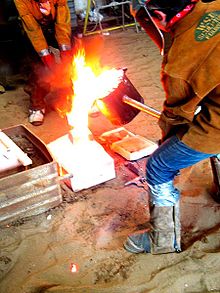Judenplatz Holocaust Memorial (Nameless Library), by Rachel Whiteread. Concrete cast of books on library shelves turned inside out.
Casting is a manufacturing process by which a liquid material is usually poured into a mold, which contains a hollow cavity of the desired shape, and then allowed to solidify. The solidified part is also known as a casting, which is ejected or broken out of the mold to complete the process. Casting materials are usually metals or various cold setting materials that cure after mixing two or more components together; examples are epoxy, concrete, plaster and clay. Casting is most often used for making complex shapes that would be otherwise difficult or uneconomical to make by other methods.[1]
Casting is a 6000 year old process.[2] The oldest surviving casting is a copper frog from 3200 BC.[2]
Contents |
Types
Metal
Metal casting is one of the most common casting processes.
Plaster, concrete, or plastic resin
Plaster itself may be cast, as can other chemical setting materials such as concrete or plastic resin – either using single-use waste molds as noted above or multiple-use ‘piece’ molds, or molds made of small ridged pieces or of flexible material such as latex rubber (which is in turn supported by an exterior mold). When casting plaster or concrete, the finished product is, unlike marble, unattractive, lacking in transparency, and so it is usually painted, often in ways that give the appearance of metal or stone. Alternatively, the first layers cast may contain colored sand so as to give an appearance of stone. By casting concrete, rather than plaster, it is possible to create sculptures, fountains, or seating for outdoor use. A simulation of high-quality marble may be made using certain chemically-set plastic resins (for example epoxy or polyester) with powdered stone added for coloration, often with multiple colors worked in. The latter is a common means of making attractive washstands, washstand tops and shower stalls, with the skilled working of multiple colors resulting in simulated staining patterns as is often found in natural marble or travertine.
See also
Notes
- ^ Degarmo, p. 277.
- ^ a b Ravi, B. (2004), Metal Casting – Overview, IIT Bombay, archived from the original on 2008-06-25, http://web.archive.org/web/20080625222749/http://www.energymanagertraining.com/foundries/pdf/CDA1.pdf.
Bibliography
| Wikimedia Commons has media related to: Casting |
- Degarmo, E. Paul; Black, J T.; Kohser, Ronald A. (2003), Materials and Processes in Manufacturing (9th ed.), Wiley, ISBN 0-471-65653-4.
This information originally retrieved from http://en.wikipedia.org/wiki/Casting
on Monday 1st August 2011 2:40 pm EDT
Now edited and maintained by ManufacturingET.org


